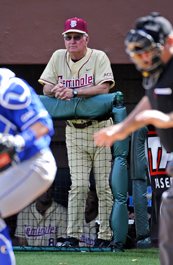June 7, 2012
Super Regional Capsules
Super Regional Picks
NCAA Interactive Bracket
Inside the Super
Regionals
By Phil Stanton and Sean Ryan
CollegeBaseballInsider.com
Co-Founders
From 64 to 16, we’ve reached the Super Regionals.
As we prepare for this weekend’s games, CBI takes a look inside
the Supers.
Seasoned Veterans
 For
the majority of the Super Regional teams, there are veteran head
coaches in the dugouts. The skippers of the 16 programs average
more than 20 years as head coaches. The youngster of the group?
Kevin O’Sullivan, who is in his fifth year at No. 1 national
seed Florida. The only other coach not it double figures is
Scott Stricklin of Kent State at eight years. The two elder
statesmen actually will go head-to-head in Tallahassee, leading
their respective alma maters with nearly 3,200 wins between
them. Mark Marquess is in his 36th season at Stanford with 1,463
victories, while Mike Martin (right) has compiled 1,719 wins in
33 campaigns. Martin and Marquess rank third and fourth among
active D-I coaches in victories, and third and seventh all-time
in D-I. Entering this season, Martin (2), South Carolina’s Ray
Tanner (9), TCU’s Jim Schlossnagle (11), Oklahoma’s Sunny
Golloway (17), Arkansas’ Dave Van Horn (18), Marquess (20),
Oregon’s George Horton (22) and Stricklin (24) ranked in the Top
25 among active coaches in winning percentage. (photo by Mike
Olivella) For
the majority of the Super Regional teams, there are veteran head
coaches in the dugouts. The skippers of the 16 programs average
more than 20 years as head coaches. The youngster of the group?
Kevin O’Sullivan, who is in his fifth year at No. 1 national
seed Florida. The only other coach not it double figures is
Scott Stricklin of Kent State at eight years. The two elder
statesmen actually will go head-to-head in Tallahassee, leading
their respective alma maters with nearly 3,200 wins between
them. Mark Marquess is in his 36th season at Stanford with 1,463
victories, while Mike Martin (right) has compiled 1,719 wins in
33 campaigns. Martin and Marquess rank third and fourth among
active D-I coaches in victories, and third and seventh all-time
in D-I. Entering this season, Martin (2), South Carolina’s Ray
Tanner (9), TCU’s Jim Schlossnagle (11), Oklahoma’s Sunny
Golloway (17), Arkansas’ Dave Van Horn (18), Marquess (20),
Oregon’s George Horton (22) and Stricklin (24) ranked in the Top
25 among active coaches in winning percentage. (photo by Mike
Olivella)
Eight is Enough
There are eight different conferences represented
in the Super Regionals. The Pac-12 and SEC lead the way with
four each, but no Super Regional matches a Pac-12 school against
one from the SEC. So, theoretically, the College World Series
field could contain teams from just these two leagues. The ACC
and Big 12 have two teams each, while America East, Big East,
Mid-American and Mountain West each have one.
Four Score
If the Pac-12 or SEC did send four teams to
Omaha, it would tie the record for most teams from one
conference in the CWS. The SEC had four in 1997 (Alabama,
Auburn, LSU, Mississippi State) and in 2004 (Arkansas, Georgia,
LSU, South Carolina). The ACC sent four in 2006 (Clemson,
Georgia Tech, Miami, North Carolina).
Planting the Seeds
There were seven national seeds and 10 No. 1
seeds that won their Regionals this past weekend. No. 6 North
Carolina was the only national seed not to advance. Three No. 2
seeds won their Regionals: Arkansas, Oklahoma and TCU. Kent
State and St. John’s were the lone No. 3 seeds to advance. And
Stony Brook became just the third No. 4 seed to win a Regional,
joining 2006 Missouri and 2008 Fresno State. The Tigers lost in
two games at Cal State Fullerton in their Super Regional, while
the Bulldogs won two straight at Arizona State after losing the
opener of the Super Regional series. Fresno State went on to win
the national championship.
One on One
There are only two match-ups of No. 1 Regional
seeds in this year’s Super Regionals: Stanford at Florida State
and NC State at Florida. Last year, there were three such
meetings, while there were six in 2010 and five in both 2009 and
2008.
 Feeling
Super Feeling
Super
Including this year’s field, there have been 65
different schools participate in a Super Regional since the NCAA
moved to the current format in 1999. There were four
first-timers a year ago: California, Connecticut, Dallas Baptist
and UC Irvine. The Golden Bears beat the Patriots to advance to
the College World Series. This year, there are also four
programs making Super Regional debuts: Kent State, Oregon, St.
John’s and Stony Brook. The Golden Flashes and Ducks will meet
in Eugene, so one of those teams will get their first Super
Regional victory. Kent State and Stony Brook are looking for
their first trips to the College World Series. Oregon has been
to Omaha once, going 0-2 in 1954. St. John’s has not been to the
CWS since 1980. (photo courtesy of St. John's Media Relations
Office)
Eyeing Omaha
NC State has been to the College World Series
once, going 2-2 in 1968. Besides the Wolfpack and the four
first-time Super Regional programs, the other 11 teams have all
been to Omaha at least once in the past eight years. Florida,
Florida State and two-time defending national champion South
Carolina are looking to reach the CWS for the third consecutive
year.
School Success
Three athletic programs had teams reach the Super
Regionals in baseball, reach the Sweet 16 in men’s basketball
and play in a bowl game in football: Baylor, Florida and NC
State. All three won their bowl games, while Baylor and Florida
reached the Elite Eight in hoops before their runs ended.
It’s Automatic
Of the 16 teams in the Super Regionals, only four
earned automatic bids. UCLA won the Pac-12 regular season crown,
while Kent State, St. John’s and Stony Brook each won its
conference tournament. The remaining 12 schools received
at-large bids.
Super Regional Success
Florida State is playing in its 12th Super
Regional, an NCAA record. Miami and Cal State Fullerton have
both appeared in 10. The Seminoles have played in 28 Super
Regional games, more than any other school. The Titans have 16
Super Regional wins, followed by Texas with 15. South Carolina
and Miami both have 14 Super Regional victories.
Home Field Advantage
In the previous 13 seasons, there has not been a
year when all home teams win their Super Regional. The largest
number has been seven, with the lowest being five.
What’s in a Name?
It’s a colorful Super Regional round with Golden
Flashes, Red Storm and Cardinal. We have Wolfpack and Seawolves.
We’re missing Lions, but we have Tigers and Bears, oh my.
Razorbacks, Horned Frogs and Gamecocks. And Sooners and Laters,
er Gators.
Batter Up
Five Super Regional teams rank in the Top 20 in
the country in batting average: Stony Brook (2 - .336), Arizona
(4 - .333), Baylor (10 - .312), UCLA (11 - .312) and Kent State
(17 - .306).
Pitching In
Five Super Regional teams rank in the Top 20 in
the country in ERA: Florida (5 – 2.85), Arkansas (7 – 2.86),
Oregon (11 – 3.02), Stony Brook (16 – 3.06) and Baylor (20 –
3.14). (South Carolina ranks No. 21 – 3.14).
Power Outage
Florida leads the nation with 71 home runs.
Stanford (tied for 25th – 46) is the only other Super Regional
team to rank in the Top 25 in the country in dingers. Arizona,
with 20 homers, has the fewest homers entering the Super
Regionals – the Wildcats’ Hi Corbett is one of the biggest parks
in college baseball. Down the line in right is 349 feet, right
center is 405, center is 392, left center is 410 and down the
line in left is 366. Hi Corbett also served as one of the parks
used in the movie Major League, and members of the
Arizona baseball team were used as extras.
Ring Em Up
Florida (3.71) and LSU (3.56) rank first and
second in the nation in strikeout-to-walk ratio. The Tigers rank
fourth with 8.7 Ks per nine innings, and NC State is sixth at
8.6.
Stars Among Us
· LSU’s
Raph Rhymes enters the Super Regionals as the nation's top
hitter at .452, 22 points higher than Danny Poma of Hofstra.
Stony Point has three hitters who rank in the top 22 in the
country: Travis Jankowski is seventh (.417), William Carmona is
16th (.393) and Maxx Tissenbaum is 22nd (.390).
· Nine
players in the country have walked 55 or more times this season,
and FSU has three of them: Sherman Johnson (63, second in
country), James Ramsey (57) and Stephen McGee (55).
· Four
freshmen ranked in the Top 20 in the country in ERA, and three
are still playing. NC State’s Carlos Rodon is fifth (1.61),
UCLA’s David Berg is seventh (1.71) and TCU’s Preston Morrison
is 18th (1.98). (Benton Moss of North Carolina is 15th.) By
comparison, there are two upper classmen in the Top 20 who are
still playing: Baylor’s Josh Turley is 11th at 1.83, and Kent
State’s David Starn is 20th at 2.01.
· Stony
Brook’s Maxx Tissenbaum is the toughest to strike out in the
nation, with a strikeout every 37.2 at-bats (6 Ks in 223
at-bats). Teammate Pat Cantwell is ninth, and LSU's Raph Rhymes
is 13th.
· Arizona’s
Kurt Heyer tied with three others for the nation’s lead in wins
with 12. LSU’s Kevin Gausman and Stony Brook’s Tyler Johnson,
who likely will face off this weekend, join FSU’s Mike Compton,
Kent State’s Tyler Skulina and Oregon’s Alex Keudell with 11
wins, tied for fifth in the nation.
|